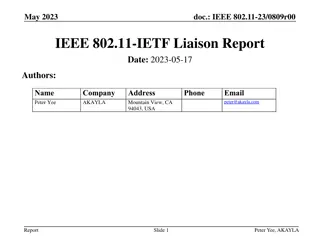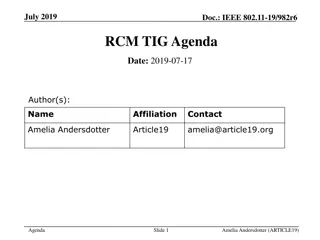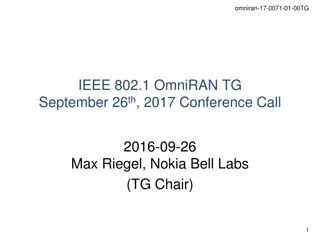IEEE Conference on ACDSA 2024 IEEE Conference on ACDSA 2024
Often challenging to decide best programming language for low-end architecture. This study compares C and Python parallel implementations on a multicore system using particle simulation, evaluating performance based on simulation details and execution times.
Download Presentation

Please find below an Image/Link to download the presentation.
The content on the website is provided AS IS for your information and personal use only. It may not be sold, licensed, or shared on other websites without obtaining consent from the author.If you encounter any issues during the download, it is possible that the publisher has removed the file from their server.
You are allowed to download the files provided on this website for personal or commercial use, subject to the condition that they are used lawfully. All files are the property of their respective owners.
The content on the website is provided AS IS for your information and personal use only. It may not be sold, licensed, or shared on other websites without obtaining consent from the author.
E N D
Presentation Transcript
IEEE Conference on ACDSA 2024 IEEE Conference on ACDSA 2024 Feb. 01 Feb. 01- -02, 2024 | 02, 2024 | Mah Mah , Seychelles , Seychelles Performance Analysis of C and Python Parallel Implementations on a Multicore System Using Particle Simulation Presenter: Abu Asaduzzaman, Associate Professor Wichita State University, USA Authors: Abu Asaduzzaman1, Venkata S.P.T. Telikepalli1, and Md Raihan Uddin1 1Wichita State University, USA Feb. 1, 2024
Performance Analysis of C and Python Parallel Implementations on a Multicore System Using Particle Simulation Outline Introduction Parallel Processing with C and Python on Multicore Systems Problem Description, Contribution Related Concepts and Work Parallel Execution of C and Python Code Simulation Details Application, Workflow, Computations Simulation Results Serial and Parallel Execution Time Conclusion Q/A Discussion CPU CPU CPU CPU GPU Single-Core Multi-Core Q/A: Questions / Answers Asaduzzaman 2 / 14
Performance Analysis of C and Python Parallel Implementations on a Multicore System Using Particle Simulation Introduction Parallel Processing using C and Python on Multicore Systems Languages for parallel processing on multicore architecture include: C, C++, Java, and Python C: translator, closer to machine language, most widely preferred [1, 2] Python: interpreter, higher level language, most popular [1, 2] Multicore Architecture with CPU/GPU: Intel, Nvidia, AMD Multithreading APIs: OpenMP, Open MPI, and CUDA OpenMP: supports C/C++, not Python because of GIL > Multithreading module supports Python Open MPI: supports both C/C++ and Python CPU: Central Processing Unit | GPU: Graphics Processing Unit | AMD: Advanced Micro Devices API: Application Programming Interface | OpenMP: Open Multi-Processing MPI: Message Passing Interface | CUDA: Compute Unified Device Architecture GIL: Global Interpreter Lock [1] S. Veeraraghavan, Top 20 Best Programming Languages To Learn in 2023, 2023. https://www.simplilearn.com/best-programming- languages-start-learning-today-article [2] 20 Top Programming Languages for 2023, 2023. https://devmountain.com/blog/20-top-programming-languages-2020/ 3 / 14
Performance Analysis of C and Python Parallel Implementations on a Multicore System Using Particle Simulation Introduction Problem Description and Contribution It is often challenging to decide which programming language should provide the best performance for a given set of low-end architecture and applications. We investigate the performance of C with OpenMP & MPI and the same of Python with multithreading & MPI using particle simulation. We simulate 1K, 5K, and 10K particles on a three-core system with CentOS and obtain the speedup due to parallel executions. 4 / 14
Performance Analysis of C and Python Parallel Implementations on a Multicore System Using Particle Simulation Related Work Execution of C and Python Figure 1 shows the major steps to execute C and Python code. The entire C code is compiled to generate the executable file. C allows memory management, offers powerful performance, but C s static nature limits dynamic features [3]. Python code is executed using an interpreter that processes each line of code sequentially. Python handles memory internally, results in performance overhead [4]. (a) C (b) Python Figure 1: Major steps for executing C and Python code [3] T. Chakrabarty, Draw the flow chart of the process of compiling and running a C program, Online Class Notes, 2015, https://onlineclassnotes.com/draw-flow-chart-of-process-of-compiling [4] S. Ravi, How Does Python Code Run: C Python And Python Difference, 2020, https://www.c-sharpcorner.com/article/why-learn- python-an-introduction-to-python/ 5 / 14
Performance Analysis of C and Python Parallel Implementations on a Multicore System Using Particle Simulation Related Work Multicore systems facilitate the work sharing of threads. MPI for C and Python During the execution of MPI, all processes use the same compiled binary, and they run the same code. In Python, we use MPI4Py, while in the C, we use the standard mpi.h library. Cython [7] is used in this work as a middleware between Python and C/C++. OpenMP Based Parallelization for C The OpenMP API is included as a header file in all C programs as an extension to facilitate multithreading usage [5]. Parallelization for Python The multithreading module helps to facilitate multithreading in Python using start(), run(), and join() methods [6]. [5] N. Singh, Automatic parallelization using OpenMP API, International Conference on Signal Processing, Communication, Power and Embedded System (SCOPES), 2016, pp. 291-294. [6] J. Anderson, An Intro to Threading in Python, Real Python, 2023. https://realpython.com/intro-to-python-threading/ [7] S. Behnel, R. Bradshaw, C. Citro, L. Dalcin, D. S. Seljebotn, and K. Smith, Cython: The best of both worlds, Computing in Science Engineering, vol. 13, no. 2, pp. 31 39, 2011. 6 / 14
Performance Analysis of C and Python Parallel Implementations on a Multicore System Using Particle Simulation Simulation Details Application: Particle Simulation [8] The particle simulation starts by generating particles with random values for position (X and Y) and velocities (X and Y) as depicted in Figure 2. We compute the equations: (1) for position, (2) for velocity, (3) for acceleration (3), and (4) for force. Figure 2: Particles in a virtual environment 7 / 14 [8] Programming Project: Parallelize Particle Simulation, GitHub, 2023. https://github.com/Nycander/ID1217--Parallelize-Particle- Simulation
Performance Analysis of C and Python Parallel Implementations on a Multicore System Using Particle Simulation Simulation Details Workflow: Serial and Parallel The process flow is illustrated in Figure 3. The number of steps in the simulation is fixed at 20 for all calculations. After creating the particles, the forces and positions are computed 20 times. Computation Environment The system consists of an Intel Xeon Gold 6240 CPU at 2.60GHz. The CPU's core architecture is x86_64. We use Python/3.9.6/GCCcore-11.2.0. (a) Serial (b) Parallel Figure 3: Flowchart for the serial and parallel execution 8 / 14
Performance Analysis of C and Python Parallel Implementations on a Multicore System Using Particle Simulation Simulation Results Serial Execution Time The execution times of C and Python serial code for particle simulation are measured for three particle sizes. As shown in Table 1, Python serial code takes more time when compared with the C serial code. Table 1: Serial execution time due to C and Python Code 9 / 14
Performance Analysis of C and Python Parallel Implementations on a Multicore System Using Particle Simulation Simulation Results Parallel Execution Time For OpenMP C, the execution time increases as the number of particles increases. However, the speedup increases with the increase of particles as shown in Figure 4. For more than 12 threads, speedup decreases. Unlike OpenMP C, for the same number of threads, the Python multithreading speedup (comparing with the respective single-thread execution time) decreases with the increase of particles as shown in Figure 5. For more than 12 threads, speedup becomes less than one. Figure 4: Speedup due to OpenMP C Figure 5: Speedup due to Python multithreading 10 / 14
Performance Analysis of C and Python Parallel Implementations on a Multicore System Using Particle Simulation Simulation Results Parallel Execution Time (+) Like OpenMP C, the MPI C execution time increases as the number of particles increases. However, the speedup increases (for up to 12 threads) with the increase of particles as shown in Figure 6. Unlike Python multithreading behavior, the MPI Python speedup (comparing with the respective single-thread execution time) increases when the number of threads increases from three to six for all particle sizes as shown in Figure 7. Figure 6: Speedup due to MPI C Figure 7: Speedup due to MPI Python 11 / 14
Performance Analysis of C and Python Parallel Implementations on a Multicore System Using Particle Simulation Simulation Results (cont d) Overall, the speedup due to OpenMP C is significant and that due to MPI C is negligible. As shown in Figure 8, the speedup due to Python code (for both multithreading and MPI) remains almost the same. Figure 8: Speedup due to C and Python code 12 / 14
Performance Analysis of C and Python Parallel Implementations on a Multicore System Using Particle Simulation Conclusion Python is one of the top most-used programming languages. However, Python cannot use OpenMP, and MPI4Py library takes a significant amount of computation time. Traditionally, C has good supports for parallel programming. Therefore, it poses a challenge to decide whether C or Python is better for a given parallel computer system. In this work, we implement particle simulation application using C with OpenMP & MPI and Python with multithreading & MPI. According to the experimental results using 1K, 5K, and 10K particles, C outperforms Python. For up to 12 threads, C OpenMP shows the best performance, followed by C MPI. As the number of threads increases, Python multithreading and MPI show worse performance. In our next endeavor, we plan to conduct parallel implementations of real-time data-dependent applications in order to better understand Python s ability for high performance computing. 13 / 14
Performance Analysis of C and Python Performance Analysis of C and Python Parallel Implementations on a Multicore Parallel Implementations on a Multicore System Using Particle Simulation System Using Particle Simulation Questions? Questions? Please send your feedback to: Abu Asaduzzaman abu.asaduzzaman@wichita.edu +1 (316) 978-5261 Thank You! Thank You!






















